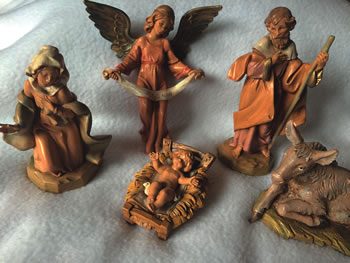Crib Origins
Growing up in the Duffy household, one of the signs of Christmas being imminent was the appearance of the crib atop the Conroy electric heater. (That was a clear, flat space off the floor and the heater was not turned on in summer.) My mother would arrange the small collection of figures with care. Baby Jesus was always the last to arrive, being put in his manger-bed after midnight mass.
We looked at, and played with, all the figures – Mary and Joseph, the Angel (whom we always referred to as ‘Gloria’ from the banner she carried) the ox and ass, the shepherds and their sheep, the mysterious magi (they were set up across the room from the rest). My nephews still make a game out of hiding the camels in unlikely places.
We think of the crib scene as ‘biblical’ but the characters come from an odd mixture of gospels and Old Testament passages.
The child laid in a manger and the visit from the shepherds is recounted in Luke’s gospel chapter 2. It is disconcerting to re-read that passage and discover that no animals are mentioned, apart from a reference to flocks being watched by night, and the manger itself - a feed-trough for livestock. Why are the ox and the ass so thoroughly embedded in our concept of Christmas?
The answer is found in the prophet Isaiah, an author beloved by the early Christians who mined his texts looking for ‘prophecies’ that were fulfilled in Christ. “Manger” is an unusual word and it features in only three Old Testament passages, one of which is the second verse of Isaiah:
Isaiah 1:2-3 The ox knows its owner and the donkey its master’s manger, but Israel does not know; my people does not understand.
The surface meaning of the verse is that the nation of Israel, in not following the way that God laid down, is dumber than your average farm animal. In the controversies of the early Church, especially when the Christians were attempting to distinguish themselves from the religion of Judaism, this line was seen as a proof-text of the rightness of Christianity. God the Father had sent the Christ into the world and the ox and ass had recognized him, even if most of his own people had not.
Possibly the earliest depiction of the crib in Christian art is the low relief carving on the lid of a sarcophagus, preserved in the base of the pulpit of the Church of St Ambrose in Milan. It dates from around 385 AD and consists of only a swaddled child, an ox and an ass.
Crib scenes are common enough in illustrated bibles, and church frescoes, but they really ‘went viral’ after 1223 AD because of a saint who knew the power of the dramatic image.
Francis of Assisi, towards the end of his life, was to celebrate Christmas in the little Italian town of Greccio and he asked his friend Giovanni Velita, the leading man of the town, “I want to celebrate the night of the Nativity with you. Choose a cave where you’re going to build a manger and conduct there an ox and a donkey, and try to reproduce, as far as possible the grotto of Bethlehem! This is my wish, because I want to see, at least once, with my own eyes, the birth of the divine infant.”
Francis, who was a deacon, sang the Gospel, and the Franciscan friars and the townsfolk lit the scene with torches and candles. Francis prayed before the cave, the manger, the ox, and the ass. The congregation felt transported back to the birth of the Lord.
According to St Bonaventure’s account of the incident “the hay of that manger, being preserved by the people, miraculously cured all diseases of cattle, and many other pestilences.”
The example of St Francis and the preaching of Franciscans ensured that the “manger scene” was popularized throughout the Catholic world, with Italy as the epicenter. Imagination, devotion and religious artifact sellers quickly populated the crib with every character mentioned or implied in the bible, plus more for dramatic effect.



 Entries(RSS)
Entries(RSS)